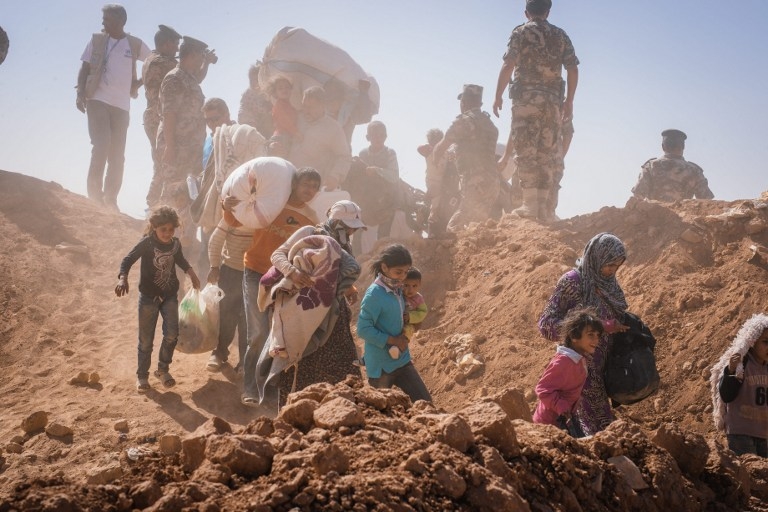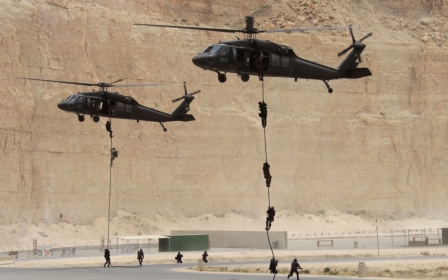As refugees are turned away, Jordan reaches its humanitarian limits

Tonight, as for nearly two weeks, the dark, lonely desert border that slices east-west between Syria and Jordan is quieter than it used to be. The white 4x4s filled with aid workers are missing, as are the army trucks and the boxes of biscuits, water, high-thermal blankets and emergency medical supplies. Babies have been born in this desert, just this side of the dirt berm that separates Jordan from the no man's land stretching north to Syria. But tonight, nothing: just the regular security patrols, the stars and the moon. No babies, no children, no keening mothers crying for the homes they lost, and no fathers bent under a load of children, suitcases and responsibility, mouths frozen in a worried line. No refugees.
Until 12 days ago, a constant stream of refugees flowed from Syria into Jordan. In late 2011 and early 2012, men, women and children fled the civil unrest in Dera’a through official border crossings like Jaber and Ramtha. As the violence ratcheted up, the human tide swelled and refugees poured across the Houran Plain, from Syria’s Dera’a into Jordan’s Mafraq, many heading straight to Za’atari refugee camp.
Water-poor, underemployed Jordan, already host to Palestinian and Iraqi refugees, opened its arms, hospitals and schools to the people many officials call “Our Syrian brothers.” Yet as the war has become more violent and the politics perpetuating it more intractable, the number of people seeking to exit Syria via its rebel-controlled southern border has mushroomed.
Jordan has coped by limiting the number of unofficial border crossings open to refugees, whilst still accepting hundreds and sometimes even a thousand-plus desperate souls each day. But on Thursday, 26 September the flow of refugees stopped - and it has yet to start again.
An internal email from a humanitarian organisation confirmed, on 1 October, that no Syrian refugees had been admitted to Jordan since late night on Wednesday, 25 September. The email also said 4,000 Syrians, mainly women and children, were stuck in the no man’s land between the two countries, unsheltered and out of reach of humanitarian aid.
On Tuesday 7 October a senior humanitarian source who is not authorised to discuss the matter confirmed that no refugees had arrived in the week since the email. “We are in a very tight situation,” he said.
Officially, the Jordanian government maintains an open border policy, offering shelter to refugees while protecting the country’s frontiers from external threats and preventing the flow of Jordanian would-be fighters to foreign battles.
Mohammad al-Momani, Jordan’s Minister of Information, said there was a balance to be struck between humanitarian and security obligations – and like any country, Jordan’s first priority was its own security. Despite the zero count of new refugees, he denied the border was closed.
“Injured people, women, children, and others are allowed in. Sometimes due to security situations delays happen but this is left to the judgment of border guards on the ground,” he said.
Those border guards liaise with Syrian rebels on the other side to manage the flow of refugees. Refugees and aid workers describe a highly choreographed operation with security checks on both sides of the border and an en masse migration cued up by cross-border calls via satellite phone.
When there is fighting nearby, as has been reported, that particular stretch of border is shut and the project resumes at another location, or once the violence has passed. But it’s unlikely that fighting on the Syrian side could account for a nearly two-week lockdown of 45 unofficial border crossings.
Another element is the timing of the change in practice: the borders closed just as Jordan announced its participation in coalition air strikes against Islamic State militants in Iraq and Syria. Curbing Syrian-origin traffic into Jordan at this time may have been seen as a way to prevent any anti-Jordanian militants from entering and doing harm to the Kingdom.
But experts say the real security issue is long-term and far more complex: whether Jordan’s infrastructure, crippled by unemployment and beset by water and fuel shortages, is capable of supporting so many long-term visitors as well as servicing its own population.
“With every refugee wave comes the obvious burden of money and policing, of stretching out a perennially bankrupt state and its services that can barely cover its own populace,” said Sean Yom, an American political scientist and an expert on Jordanian politics.
The senior humanitarian agreed. “There’s a need for infrastructure, for equipment for desalination plants and wastewater networks, for electricity generators and discounted gas,” he said.
“The international community needs to make up for the responsibility Jordan is facing. Why can’t the Gulf countries halve the price of oil to Jordan? Why can’t we allow Jordanian products and services more access to European markets?”
The view from the Jordanian government, he said, was that global interest had shifted away, to Central Africa, Ukraine and Iraq, and that Jordan, lumbering under a $20bn USD deficit, was left to bear this burden on its own. He pointed out that it took just three days to pump $9bn USD into Egypt when the country was falling. “Is the international community waiting for Jordan to fall? Must we hit a crisis point before the world responds?”
But Yom thinks the real crisis point and the reason Jordan has so emphatically clamped down on the flow of refugees has less to do with the country’s means and more to do with its identity.
Jordan has long opened its doors to refugees, but few of them have left. Between half and two thirds of the country’s population is Palestinian, and surges of Iraqi refugees after the first Gulf war and the 2003 US invasion of Iraq have edged Jordan’s original, East Banker - so called for being on the East Bank of the River Jordan - population down to just 20 percent of the country’s total.
“For the less moderate East Bank faction, the motivating emotion is fear – fear of always being the minority in a land swamped with outsiders. There’s no enthusiasm for, say, extending citizenship to Syrians or providing for long-term accommodations,” says Yom.
While Yom doesn’t envisage Palestinian and Syrian elements colluding in any social movement against the Jordanian regime, he believes the Palestinian experience has shaped Jordan’s expectations.
“There’s an incentive for them to eject the existing refugee populace, or at least staunch the tide, because the longer they stay, the more likely they will create a rooted life that will make them not return even if the opportunity arises,” he said.
On the streets of Amman, Irbid and Mafraq, that rooted life is already visible. Coffee boys with Syrian accents dart from shop to shop, and Syrian children sell jars of maqdoos aubergine pickles made by their refugee mothers. Damascene sweets and ice cream are for sale, and business is brisk for the Syrians who can grab the business opportunity. Locals, too, are benefiting: rents are rising, and at a recent Syrian wedding in Zarqa, the Jordanian drummers hired for the occasion work almost exclusively at Syrian weddings.
But this sort of change comes at a price, Yom notes, and that price, at its highest, is a prolonged state of demographic, social, and institutional chaos. The real fear among the East Banker minority, he says, is that the cost of absorbing Syrians will be a profound change to the character of the state itself.
“From that perspective, you are looking at a demographic disaster of historic proportions. You want to do anything possible, damn the humanitarian concerns, to stop the refugee flows, expel existing outsiders, and reconsolidate the state,” he said.
Most of the Syrians who have already made it over the border and into Jordan say they just want to go home. Most are unable to work legally, and the high cost of living plus low wages on the informal market make life as a refugee markedly harder than it was in pre-war Syria. But they’re safe. And while some Syrians choose to return home, the bulk of the population is staying put as long as it takes to stay safe – a prospect that very likely led to the closed door facing so many of their cousins, brothers and sisters just a few miles north.
New MEE newsletter: Jerusalem Dispatch
Sign up to get the latest insights and analysis on Israel-Palestine, alongside Turkey Unpacked and other MEE newsletters
Middle East Eye delivers independent and unrivalled coverage and analysis of the Middle East, North Africa and beyond. To learn more about republishing this content and the associated fees, please fill out this form. More about MEE can be found here.




